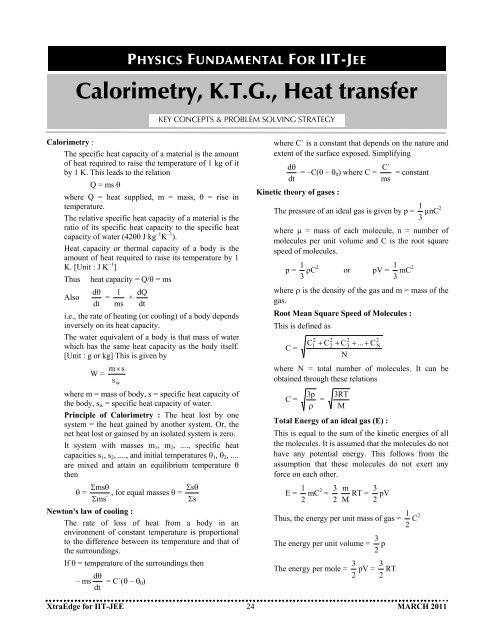March 2011 - Career Point
March 2011 - Career Point
March 2011 - Career Point
You also want an ePaper? Increase the reach of your titles
YUMPU automatically turns print PDFs into web optimized ePapers that Google loves.
PHYSICS FUNDAMENTAL FOR IIT-JEE<br />
Calorimetry, K.T.G., Heat transfer<br />
KEY CONCEPTS & PROBLEM SOLVING STRATEGY<br />
Calorimetry :<br />
The specific heat capacity of a material is the amount<br />
of heat required to raise the temperature of 1 kg of it<br />
by 1 K. This leads to the relation<br />
Q = ms θ<br />
where Q = heat supplied, m = mass, θ = rise in<br />
temperature.<br />
The relative specific heat capacity of a material is the<br />
ratio of its specific heat capacity to the specific heat<br />
capacity of water (4200 J kg –1 K –1 ).<br />
Heat capacity or thermal capacity of a body is the<br />
amount of heat required to raise its temperature by 1<br />
K. [Unit : J K –1 ]<br />
Thus heat capacity = Q/θ = ms<br />
dθ 1 dQ<br />
Also = ×<br />
dt ms dt<br />
i.e., the rate of heating (or cooling) of a body depends<br />
inversely on its heat capacity.<br />
The water equivalent of a body is that mass of water<br />
which has the same heat capacity as the body itself.<br />
[Unit : g or kg] This is given by<br />
m×s<br />
W =<br />
s w<br />
where m = mass of body, s = specific heat capacity of<br />
the body, s w = specific heat capacity of water.<br />
Principle of Calorimetry : The heat lost by one<br />
system = the heat gained by another system. Or, the<br />
net heat lost or gainsed by an isolated system is zero.<br />
It system with masses m 1 , m 2 , ...., specific heat<br />
capacities s 1 , s 2 , ...., and initial temperatures θ 1 , θ 2 , ....<br />
are mixed and attain an equilibrium temperature θ<br />
then<br />
θ =<br />
Σmsθ<br />
, for equal masses θ =<br />
Σms´<br />
Σsθ<br />
Σs<br />
Newton's law of cooling :<br />
The rate of loss of heat from a body in an<br />
environment of constant temperature is proportional<br />
to the difference between its temperature and that of<br />
the surroundings.<br />
If θ = temperature of the surroundings then<br />
dθ<br />
– ms = C´(θ – θ0 )<br />
dt<br />
where C´ is a constant that depends on the nature and<br />
extent of the surface exposed. Simplifying<br />
dθ C<br />
= –C(θ – θ0 ) where C = = constant<br />
dt<br />
mś<br />
Kinetic theory of gases :<br />
The pressure of an ideal gas is given by p = 3<br />
1 µnC<br />
2<br />
where µ = mass of each molecule, n = number of<br />
molecules per unit volume and C is the root square<br />
speed of molecules.<br />
p = 3<br />
1 ρC<br />
2<br />
or pV = 3<br />
1 mC<br />
2<br />
where ρ is the density of the gas and m = mass of the<br />
gas.<br />
Root Mean Square Speed of Molecules :<br />
This is defined as<br />
2<br />
2<br />
2<br />
C1 + C2<br />
+ C3<br />
+ ... + CN<br />
C =<br />
N<br />
where N = total number of molecules. It can be<br />
obtained through these relations<br />
C =<br />
3p<br />
ρ<br />
=<br />
3RT<br />
M<br />
Total Energy of an ideal gas (E) :<br />
This is equal to the sum of the kinetic energies of all<br />
the molecules. It is assumed that the molecules do not<br />
have any potential energy. This follows from the<br />
assumption that these molecules do not exert any<br />
force on each other.<br />
1<br />
E = mC 2 3 m 3<br />
= RT = pV<br />
2 2 M 2<br />
Thus, the energy per unit mass of gas = 2<br />
1 C<br />
2<br />
The energy per unit volume = 2<br />
3 p<br />
The energy per mole = 2<br />
3 pV = 2<br />
3 RT<br />
2<br />
XtraEdge for IIT-JEE 24 MARCH <strong>2011</strong>

















